It’s Women’s History Month.
To celebrate, we’re profiling 12 women who were pioneers in the field of health and medicine—with a twist. We’re writing about them in first person as if they had access to today’s news.
1. The Founder
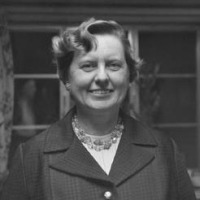 I was a mother of two daughters. But when it comes to my work, some people called me a mother and a father. Perhaps the more accurate word would be founder. Let me tell you about myself.
I was a mother of two daughters. But when it comes to my work, some people called me a mother and a father. Perhaps the more accurate word would be founder. Let me tell you about myself.
I was definitely out of the mainstream. I foresaw genetic sequencing way before it became a key source of biological information.
As a biochemist who developed compilations of protein structures, I introduced the single letter descriptions to facilitate computer analysis, established a large computer database of protein structures, and was the author of the Atlas of Protein Sequence and Structure. My work was used in genetic engineering and medical research. I was also delighted to contribute to the understanding of the evolutionary tree based on correlations between proteins and living organisms.
At the time of my death, I was associate director of the National Biomedical Research Foundation and a professor of physiology and biophysics at Georgetown University Medical Center, but I am perhaps best known as the founder of the field of bioinformatics. (It was former head of NCBI David Lipman who first said I was the mother and father of bioinformatics.)
Needless to say, if I were alive today, I would be very interested in the work of NCBI and delighted to see so many women excelling in my field.
Who am I?
[On a touchscreen? Answers below.]
2. The Critic
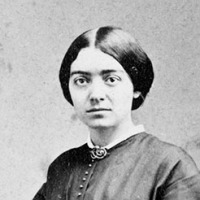 I was born at a time when I needed to be critical—critical of a system and a society that excluded women from too many opportunities.
I was born at a time when I needed to be critical—critical of a system and a society that excluded women from too many opportunities.
My need to petition started early. I had to convince the Female Medical College of Pennsylvania to let me sit for my medical exams early. In protest over the allowances made for me, the dean, a man, resigned. You could call it sweet revenge when a woman—Ann Preston—took over his position and became the first woman dean of a medical school.
My first chance to practice medicine came from another female graduate, Marie Zakrzewska, who founded the New England Hospital for Women and Children. But I wanted more and better training, which I did not believe the women’s medical schools in the US could provide, so I left for Paris, where, after much perseverance, I gained admission to the Ecole de Medicine.
When I returned, I was so energized that I organized the Association of the Medical Education of Women in New York. (Later, it became the Women’s Medical Association of New York City.)
I married Dr. Abraham Jacobi, who became known as the “father of American pediatrics.” Luckily, he advocated for my being admitted to medical societies of New York.
My essay “The Question of Rest for Women during Menstruation” was influential. Today, you take it for granted that a woman can compete and work any day of the week. This wasn’t’ always the case. Through tables, statistics, and sphygmographic tracings, I proved that women were strong and agile throughout their monthly cycle. I was also an attending and practicing physician. I even opened a children’s ward at the New York Infirmary in 1886.
You’d have thought I would have been a shoo-in for membership to the Academy of Medicine. But I wasn’t. It took one person’s vote to put me in the majority for membership.
Who am I?
[On a touchscreen? Answers below.]
3. The Angel
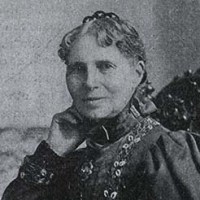 I lived four miles from NLM. You can take a tour of my house and learn a lot about me. If you do, check out the backless chair in my office. I believe it helped my posture. See my dining room. I was a vegetarian. See a photo of me wearing more than a dozen medals. Many people agree that I deserved them.
I lived four miles from NLM. You can take a tour of my house and learn a lot about me. If you do, check out the backless chair in my office. I believe it helped my posture. See my dining room. I was a vegetarian. See a photo of me wearing more than a dozen medals. Many people agree that I deserved them.
In my long life, I was a teacher, a founder of a free public school, and a US Patent Office clerk. During the Civil War, I cared for soldiers in the field and organized relief efforts on their behalf. After the war, I ran an Office of Missing Soldiers in Northwest Washington. Later, I organized the American Red Cross. (Throughout my career, NLM’s Specialized Information Services would have been so helpful!)
My life wasn’t easy. I had bouts of depression, and I lived at a time when it was very challenging for women to be respected in their work. I remember having men spit tobacco on my skirts when I worked. But I was tough, and whatever I did, I did with passion to help others.
I was called the “Angel of the Battlefield” for my work during the Civil War.
Who am I?
[On a touchscreen? Answers below.]
4. The Memoir Writer
 If I had been born under different circumstances, I would have been as famous as #3 above.
If I had been born under different circumstances, I would have been as famous as #3 above.
If you were a black soldier during the Civil War who got wounded or sick, I would have been there for you. If you didn’t know how to read or write, I would have taught you.
I knew at an early age how tough life could be. I was born into slavery and learned in secret how to read and write by going to a school run by an African American woman who was free. As you might imagine, this school was illegal. Later, other “teachers,” who were both black and white, helped me learn
During the Civil War, I not only nursed wounded African American soldiers, I taught as a many as I could to read. Education and health care were so important to me.
My memoir about the Civil War was published in 1902. I was recognized in the NLM exhibition “Binding Wounds, Pushing Boundaries: African Americans in Civil War Medicine.”
The curator of the exhibition chose to highlight this quote from my book:
“It seems strange how our aversion to seeing suffering is overcome in war … and instead of turning away, how we hurry to assist in alleviating their pain, bind up their wounds, and press cool water to their parched lips, with feelings only of sympathy and pity.”
Who am I?
[On a touchscreen? Answers below.]
5. Creator of a Famous Test
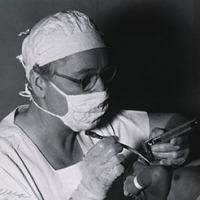 If you had a baby or were a baby born in the past 40 years or so, chances are you were given a score at birth, which was named after me. Prior to my test, many doctors waited until it was too late to determine an infant’s health. The two-minute wait for the cry could be fatal if an infant was in distress.
If you had a baby or were a baby born in the past 40 years or so, chances are you were given a score at birth, which was named after me. Prior to my test, many doctors waited until it was too late to determine an infant’s health. The two-minute wait for the cry could be fatal if an infant was in distress.
In addition to being an anesthesiologist and promoter of maternal health, I was an athlete, a musician, a golfer, and a fly fisher. I talked fast and drove fast. I even took flying lessons. But I never married. If you’d have asked me why, I would have told you I hadn’t met a man who could cook.
As part of its Profiles in Science project, the National Library of Medicine collaborated with the Mount Holyoke College Archives and Special Collections to digitize and make available a selection of my papers. I think you’ll enjoy learning more about me.
Who am I?
[On a touchscreen? Answers below.]
6. The Nurse
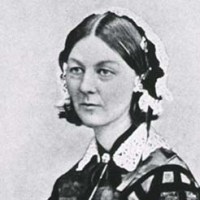 I hear that NLM’s director is a nurse. That is so awesome! I was a nurse, too.
I hear that NLM’s director is a nurse. That is so awesome! I was a nurse, too.
Born at a time and in a place where wealthy women were expected to become wives and mothers, I had other plans. I became a nurse. At a time when the sick and poor were cared for by other poor people, I advocated that they receive care from people with medical training.
I helped plan hospitals. I became a renowned statistician and epidemiologist (although I wasn’t called that). I even invented a new form of the pie chart. I also founded a school for nursing. Come to think of it, I did a lot of things, but I’m best known as founder of the modern nursing profession.
Who am I?
[On a touchscreen? Answers below.]
7. The Advocate
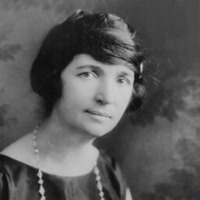 I was an early advocate for something still considered controversial in some circles. I felt that in order for women to have equal footing in society, they needed the power to decide when and if they became pregnant. I actually coined the term “birth control.”
I was an early advocate for something still considered controversial in some circles. I felt that in order for women to have equal footing in society, they needed the power to decide when and if they became pregnant. I actually coined the term “birth control.”
Early in life, two of my older sisters supported me in my education as a I attended Claverack College and Hudson River Institute, before becoming a nurse probationer at White Plains Hospital. Like Woman Number 2 above, I worked as a visiting nurse, helping in the slums on the east side of New York. My nursing experiences helped inform my views.
It wasn’t easy. I was arrested several times for making birth control available. When I told the judge I couldn’t respect the law against birth control, I was sentenced to 30 days in a workhouse.
My trial generated a lot of publicity. Finally, 100 years ago, in 1918, the birth control movement was victorious when a judge in New York issued a ruling that allowed doctors to prescribe contraception. But more importantly, the publicity surrounding my trial helped more people advocate for birth control.
I continued working to promote and explain birth control for the rest of my life.
Who am I?
[On a touchscreen? Answers below.]
8. First Female African American Doctor
 I was the first African American woman in the United States to earn an MD.
I was the first African American woman in the United States to earn an MD.
Would you like to take a guess when I earned my medical degree? 1864? 1894? 1924? 1944?
The year was 1864.
I was born in 1831 in Delaware but was raised in Pennsylvania by my aunt, who was a caretaker for many in the area. In 1852, I had moved to Massachusetts, where I worked as a nurse for eight years despite my lack of formal training. But don’t judge me—I would have gone to school if it had been available.
Fortunately, that work helped me get letters of recommendation from physicians in Massachusetts, and I was admitted to the New England Female Medical College in 1860. Four years later, I had earned my medical degree. Alas, the school closed in 1873.
I practiced in Boston for a short period of time before moving to Richmond, Virginia, after the Civil War ended in 1865. I worked with other black physicians caring for formerly enslaved individuals who wouldn’t have had access to care.
There isn’t very much known about me, but the introduction of Book of Medical Discourses, which I published in 1883, offers some insight. You can learn a bit more about me through NLM’s Changing the Face of Medicine.
Who am I?
[On a touchscreen? Answers below.]
9. The Prize Winner
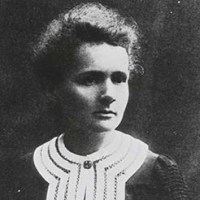 I wasn’t allowed to study at the University of Warsaw because I was female, so I joined a bunch of other students at a clandestine university. Our classes met at night so we could avoid the czar’s police. My favorite subjects were math, chemistry, and physics.
I wasn’t allowed to study at the University of Warsaw because I was female, so I joined a bunch of other students at a clandestine university. Our classes met at night so we could avoid the czar’s police. My favorite subjects were math, chemistry, and physics.
When I had made enough money, I left for Paris to study. In Paris, I ended up working in a lab with Pierre, the man who would become my husband. We became famous for pioneering research on radioactivity, and we even extracted two previously unknown elements—polonium and radium. Together we (and Henri Becquerel) shared the 1903 Nobel Prize in physics for that work.
But the 1911 Nobel Prize in chemistry was all mine.
The award recognized my ability to produce radium as a pure metal and document its properties. I was the first woman to win a Nobel Prize, the first person and only woman to win twice, the only person to win a Nobel Prize in two different sciences. Unfortunately, I didn’t live long enough to see my daughter Irène Joliot-Curie win the Nobel Prize in chemistry in 1935 with her husband.
Although I’m best known for my Nobel Prize-winning work, I can’t resist telling you about my efforts in mobile medicine. During World War II, we procured X-ray equipment and generators to create mobile units called petites Curies (“little Curies”) that we could position close to the front. They remind me of the work being done by NLM’s Lister Hill National Center for Biomedical Communications to build mobile screeners to diagnose tuberculosis. Their system travels by truck throughout Kenya, making it possible for more people to get screened and treated.
Who am I?
[On a touchscreen? Answers below.]
10. The Unexpected Stateswoman
 I was about as disadvantaged as a kid could get during the Reconstruction Era. Born on July 10, 1875, in a tiny village near Maysville, South Carolina, I was poor, black, and female.
I was about as disadvantaged as a kid could get during the Reconstruction Era. Born on July 10, 1875, in a tiny village near Maysville, South Carolina, I was poor, black, and female.
Yet throughout my life, I turned perceived negatives into positives. On land dismissed as a dump in Daytona Beach, Florida, I started a school, which today is a university with schools that include nursing, health sciences, science, engineering, and mathematics. At a time when African American women had difficulty getting employment in white collar positions, I was an advisor to President Franklin D. Roosevelt. In addition, I was vice president of the NAACP and president and founder of the National Council of Negro Women.
You might be surprised to know that the very first statue erected on public land in Washington, DC, to honor an African American and a woman is of me. Come by and visit anytime you’re near Capitol Hill.
Who am I?
[On a touchscreen? Answers below.]
11. The Inspirer
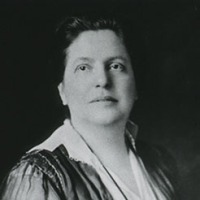 I hear that my work inspired an online and traveling exhibition, which NLM’s History of Medicine Division has developed and which will debut in June. Needless to say, I’m flattered.
I hear that my work inspired an online and traveling exhibition, which NLM’s History of Medicine Division has developed and which will debut in June. Needless to say, I’m flattered.
I was born two years after the Civil War ended. I attended Miss Cruttenden’s English-French Boarding and Day School for Young Ladies. Can you believe a school could be called that? At least it was named after a woman! I wanted to attend Vassar College when I was 16, but the school thought I was too young. Undeterred, I attended the New York Hospital’s School of Nursing, graduated from the New York Hospital Training School for Nurses, and took courses at the Woman’s Medical College.
I founded the Henry Street Settlement in New York City’s Lower East Side, and I advocated for having nurses in public schools. I believed that every New York City resident was entitled to equal and fair health care regardless of their social status, socio-economic status, race, gender, or age. But my activism didn’t stop there. I also campaigned for suffrage, supported racial integration, and was involved with the founding of the NAACP.
Even if you don’t know my name, chances are you have heard of the term I coined: “public health nurse.”
Who am I?
[On a touchscreen? Answers below.]
12. A Towering Figure
 Before there was the National Library of Medicine, there was the Army Medical Library in Washington, DC, and I was a proud leader. I helped develop the first selection and acquisitions policy for the Army Medical Library and helped craft legislation for the Medical Library Assistance Act.
Before there was the National Library of Medicine, there was the Army Medical Library in Washington, DC, and I was a proud leader. I helped develop the first selection and acquisitions policy for the Army Medical Library and helped craft legislation for the Medical Library Assistance Act.
My career highlights also included being director of the Washington University Medical Library in St. Louis and serving as president of the Medical Library Association. I was active in international activities throughout much of my career, although my international work isn’t as well-known as my achievements in library leadership, automation, education, and medical history.
The Medical Library Association said I was a “towering figure” who left behind “a powerful body of work in the fields of library automation, medical literary education, history of medicine, and international librarianship.”
Indeed, I was active in MLA and the Special Libraries Association (SLA). I was honored with MLA’s Marcia C. Noyes Award, delivered the Janet Doe Lecture, and received the SLA John Cotton Dana Award.
In my oral history, I said, “I find learning a great joy and a great pleasure, and I don’t understand people who don’t get any pleasure of something new and different and exciting which they had not thought of before, or they don’t get any feeling of satisfaction out of following an argument to its logical conclusion or examining something from various points of view and trying to get a rounded picture of a phenomenon. …[Others] think of learning as something they are required to do, and I think of learning as something I want to do.”
Chances are you enjoy learning, too.
Who am I?
[On a touchscreen? Answers below.]
Thank you for taking time to read about women who have advanced their professions or were pioneers in the fields of medicine, nursing, public health, or medical librarianship.
If you enjoyed “Who Am I?”, would you take a moment to suggest women we could consider featuring next year? Thank you!
By Kathryn McKay, NLM in Focus writer
The Answers
- The Founder: MARGARET OAKLEY DAYHOFF (1925-1983)
- The Critic: MARY CORINNA PUTNAM JACOBI (1842–1906)
- The Angel: CLARISSA “CLARA” HARLOWE BARTON (1821 –1912)
- The Memoir Writer: SUSIE KING TAYLOR (1848-1912)
- Creator of a Famous Test: VIRGINIA APGAR (1909-1974)
- The Nurse: FLORENCE NIGHTINGALE (1820-1910)
- The Advocate: MARGARET HIGGINS SANGER (1879-1966)
- First Female African American Doctor: REBECCA LEE CRUMPLER (1831-1895)
- The Prize Winner: MARIE CURIE (1867-1934)
- The Unexpected Stateswoman: MARY JANE McLEOD BETHUNE (1875-1955)
- The Inspirer: LILLIAN D. WALD (1867–1940)
- A Towering Figure: ESTELLE BRODMAN (1914-2007)


Thanks very much for including Rebecca (Lee) Crumpler in this list. Two ideas for next year’s feature: America’s first trained nurse, Linda Richards (PMID: 18892202, for instance) and Mary Eliza Mahoney, America’s first African American nurse (PMC2617375, for in stance).
Thank you Martha.
What wonderful ideas for next year!
Pingback: Weekly Postings | The MARquee
Thanks for the opportunity to learn about these notable women.
Pingback: Who Am I? Twelve Notable Women in Medical History – Heathy Casa
Another suggestion from a reader:
I’ve always admired Tenley Albright and thought it was amazing that she went from figure skater to surgeon. How many women became surgeons in the 1960s? And she headed the Board of Regents, too.
From Wiki:
A graduate of The Winsor School in Boston, Albright entered Radcliffe College in 1953 as a pre-med student,[6] and focused on completing her education after the 1956 Olympics.[7] She graduated from Harvard Medical School in 1961, went on to become a surgeon,[7][8] and she practiced for 23 years, continuing as a faculty member and lecturer at Harvard Medical School. For a while she chaired the Board of Regents of the National Library of Medicine at the National Institutes of Health. As a director, she has served both not-for-profits such as The Whitehead Institute for Biomedical Research and the Woods Hole Oceanographic Institution and for-profit enterprises such as West Pharmaceutical Services, Inc., and State Street Bank and Trust Company.[9] She is currently the Director of the MIT Collaborative Initiatives.
Posted with permission from Melissa Yorks.
One reader suggests former NIH Cardiac Surgeon by the name of Nina Braunwald MD. Doug Atkins says, “She was one of a kind when men still dominated the practice of medicine and in particular surgery. . . .She must have had a mountain of energy and equal parts ability to focus.”
Thank you, Doug.
We’re always delighted to hear from our readers.
Pingback: Google Doodle Celebrates Birthday of Dr. Virginia Apgar and We Do, Too! | NLM in Focus
Pingback: Google Doodle Celebrates Birthday of Dr. Virginia Apgar and We Do, Too! – Heathy Casa
Pingback: Google Doodle Celebrates Birthday of Dr. Virginia Apgar and We Do, Too! – Source
Pingback: What are you reading this summer? | NLM in Focus
Pingback: 2018’s Seasons of Stories from NLM in Focus | NLM in Focus
Pingback: Who Am I? 12 Notable Women in Medical History | NLM in Focus
Pingback: Notable Women in Medical History | The University of Chicago Library News
Pingback: Influential Women in Healthcare History - PlushCare
Pingback: oatcakes&snowdrops*: Jennie Trout – Lorraine's frilly freudian slip
Pingback: Fletcher: The Forgotten Founder – Circulating Now from NLM